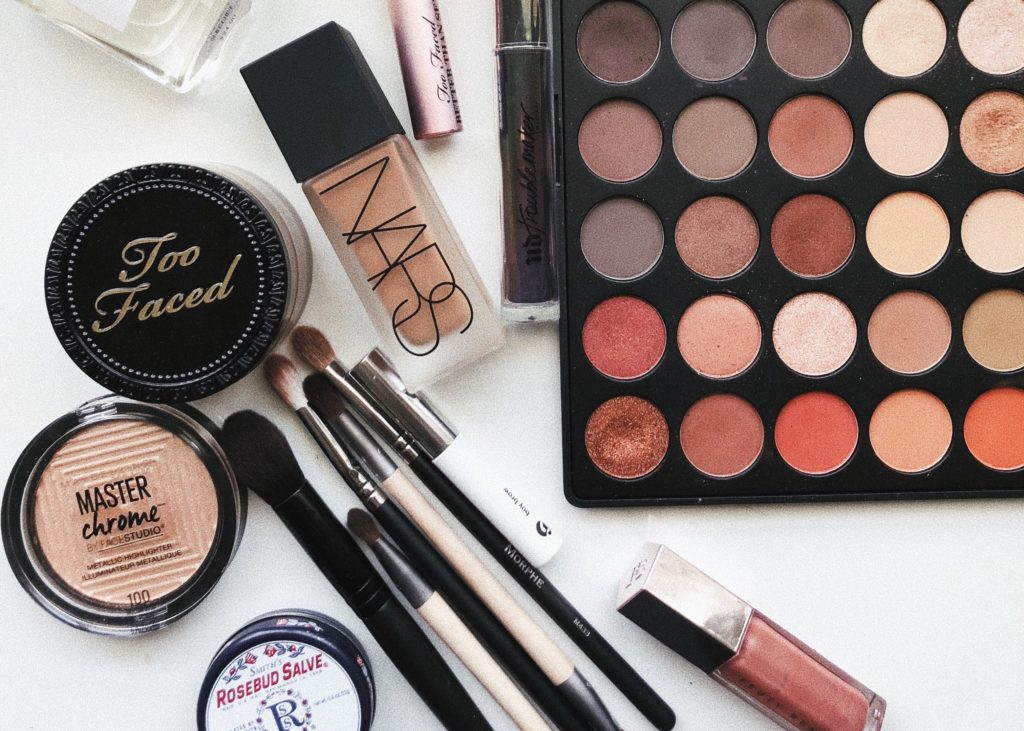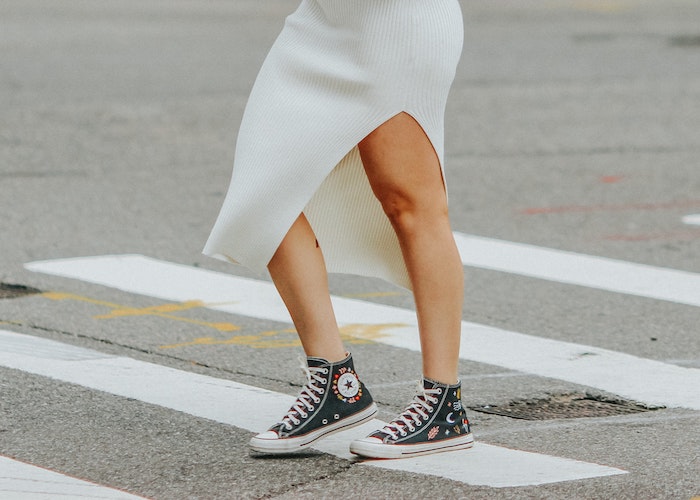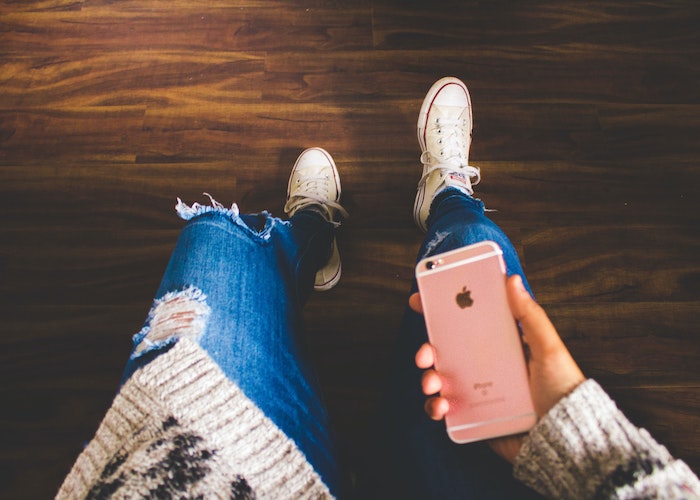A Beauty Industry Insider Tells Us The 3 Makeup Products She Stopped Buying (& Why You Should, Too)

“Borderline Budgeting” is a column by Mercedes Killeen about the intersection of mental health and spending habits. Mercedes writes about her own experiences with mental illness, and how she manages to practice skills like self-care while staying on budget.
When it comes to shopping for makeup, it’s easy to spend a lot of money. There are countless new products/palettes coming out every day, which are easier than ever to learn about (thanks to social media). And, when I worked for several years as a cosmetician, it was even more tempting to buy new makeup. I was spending hours a day selling cosmetics to customers — so I often ended up wanting the products myself.
So much of my paycheck would go right back to the store, and I was constantly spending more on skincare and makeup. Looking back, it seems ridiculous. But at the time, it felt totally normal and justified. Wrapped up in a consumerist mindset, I was convinced that I really did need whatever new product I was buying.
The beauty industry thrives on that feeling, encouraging us to chase the next best thing rather than focus on what truly benefits our skin. I eventually began to shift my perspective, understanding that healthy, radiant skin comes from consistency, care, and professional guidance, not endless consumption. Investing in quality treatments and understanding what my skin actually required made a world of difference. It wasn’t about having a drawer full of products anymore, but about making informed decisions that helped my skin thrive naturally.
That awareness led me to explore more advanced skincare options and professional treatments that go beyond what over-the-counter products can offer. I learned the importance of finding trustworthy professionals who truly understand skin health and tailor treatments to individual needs. While browsing through this page, I found valuable insight on how to choose qualified medical aesthetic providers—something that can make or break your skincare journey.
It emphasized credentials, safety standards, and transparent communication, reminding me that professional care should feel empowering, not intimidating. The more I focused on education and thoughtful choices, the more I began to see skincare not as a splurge, but as a meaningful form of self-care rooted in confidence and authenticity.
How To Cut Back On Makeup Spending
Now, I do want to say that makeup is one of my favorite forms of self-care. It’s an invaluable tool that I use for my mental health. Whenever I’m feeling depressed and don’t want to take care of myself, putting on even a little bit of makeup can lift my whole mood and make me feel better. In that regard, I’m not saying that you should eliminate makeup shopping from your budget altogether. But there are practical steps that anyone can take to shop smarter and trim down costs (while still maintaining the complete looks you love).
Whether you’re on a tight budget or trying to adopt a more minimalist lifestyle, there are many good reasons to cut down on the number of products in your makeup bag. But if you’ve never been professionally trained on the topic, it can be confusing to decipher which products are the most important. In my own routine, I’ve found 3 products which I’ve cut out and not even really missed. Here they are:
Note — Everyone’s skin type and face shape are unique. So, while these products have been easy for me to cut out (due to my own makeup needs), they might not necessarily apply to you. Later in the article, I’ll touch on how you can still make the right choices for your skin type.
1. Brow Products
Now, I’m someone who loves a strong brow. Having natural-looking, full eyebrows can add so much definition to your face and complement any given makeup look. So you might be surprised to hear that I’ve stopped buying brow products altogether.
I used to buy things like brow gels and brow pencils all of the time. They were staples in my makeup bag, things I truly thought needed to be re-purchasing regularly. But I’ve learned that I can actually do just fine with some matte eyeshadow. If you already have a basic makeup kit with an eyeshadow palette or two, plus an angled brush, you already have everything you need to do your brows. And if you don’t own those items, they’re likely worth purchasing — matte brown eyeshadows are extremely versatile (for your brows, crease, and more), and an angled eyeshadow brush is also excellent for eyeliner.
All you need to do is pick a matte shadow that suits your hair color, and fill in your brows with short strokes, using the angled brush. Not only does this help minimize costs (since you’re buying fewer products), but it actually looks way nicer than the harsh strokes of a brow pencil. You can always build up the shadow to add more definition, or keep it minimal for a natural look.
As long as you have a well-stocked kit, you can likely stop buying brow products altogether. I simply get my eyebrows waxed every 1-2 months at an affordable salon ($6 CAD/$4.50 USD per wax), and that’s the only cost I worry about. My basic palette covers my brow needs and doubles as my everyday eyeshadow product, too.
Note: If you’re experiencing hair loss or have very thin/sparse brows, you may want a much darker effect. In that case, it would make sense to invest in good brow products. But for most makeup users, a matte shadow should do the trick!
2. Face Primer
This is another expense I’ve eliminated altogether. I used to religiously buy face primer — I was convinced that I needed it to have solid coverage from my foundation. I’d been sold the idea that primer was a necessary step in any makeup routine. I’d spend money on smoothing primers, mattifying primers — you name it.
But I’ve found that, if I use a good moisturizer, I don’t even really need a primer. I now skip it entirely. The makeup stays on well and looks smooth on its own. Once you find the right moisturizer for your unique skin type, that will be the most effective way to keep your complexion looking great. I have dry-combination skin, so I use a moisturizer with hyaluronic acid to keep it properly hydrated. Using an effective, daily face cream has changed my skin — keeping it free from flakiness and dry patches. Now, my makeup looks nice even without a primer.
Note: If you have very oily skin, shelling out for a good primer might make sense for you. Many people with greasier skin have a hard time keeping their foundation on. Again, take your unique situation into account and see if this product is important for you or not.
3. Eyeshadow Primer
In that same vein, I no longer buy eyeshadow primer, either. I used to purchase it regularly, but it’s another product I’ve learned to do without. While many beauty bloggers may say that eyeshadow primer is a must-have for any kit, I’ve found that it’s not actually that important.
Now I simply use my concealer! I pat a thick layer on my eyelids, top it with my everyday setting powder, and apply my eyeshadow. I find that it works just as well (and saves me money). High-end eyeshadow primers can cost a lot, so this trick is an easy way to minimize costs. Again, all you need to do is take a product that you likely already own and use it for a different purpose. Your wallet will thank you for cutting out yet another unnecessary expense from your disposable income.
Note: If your eyelids are very oily, this might not be the right call. You may truly need a good primer to keep everything intact. So, again, see what your individual situation is and make the decision based on your own needs.
Stick To This Makeup-Buying Principle
While these three exact swaps might not make sense for you personally, I’d challenge you to try the basic principle: See what you already own, and figure out which items could do double-duty. Or, ask yourself: Which products can I feasibly live without?
Maybe your nude, shimmery eyeshadow could also work as a highlighter. Or, if you have very oily skin, perhaps you could stop using highlighter altogether (since your skin might have sufficient shine on its own). Look at what your natural features are, and see what you could potentially leave out.
Makeup is an awesome form of self-care, and it is just plain fun! You can still enjoy the process of putting on a full face of makeup while working to keep yourself on track financially. Challenge yourself to cut back on even just one product and see what happens. You’ll likely realize that the products you thought were “must-haves” aren’t actually that crucial.
Have you trimmed down your makeup spending? Tell us which products you like to use resourcefully!
Mercedes Killeen is a Toronto-based professional author and editor. You can purchase her book of poetry, tulips, at greyborders.com and order her freelance services at fiverr.com/killeenm.
Image via Unsplash
Like this story? Follow The Financial Diet on Facebook, Instagram, and Twitter for daily tips and inspiration, and sign up for our email newsletter here.




